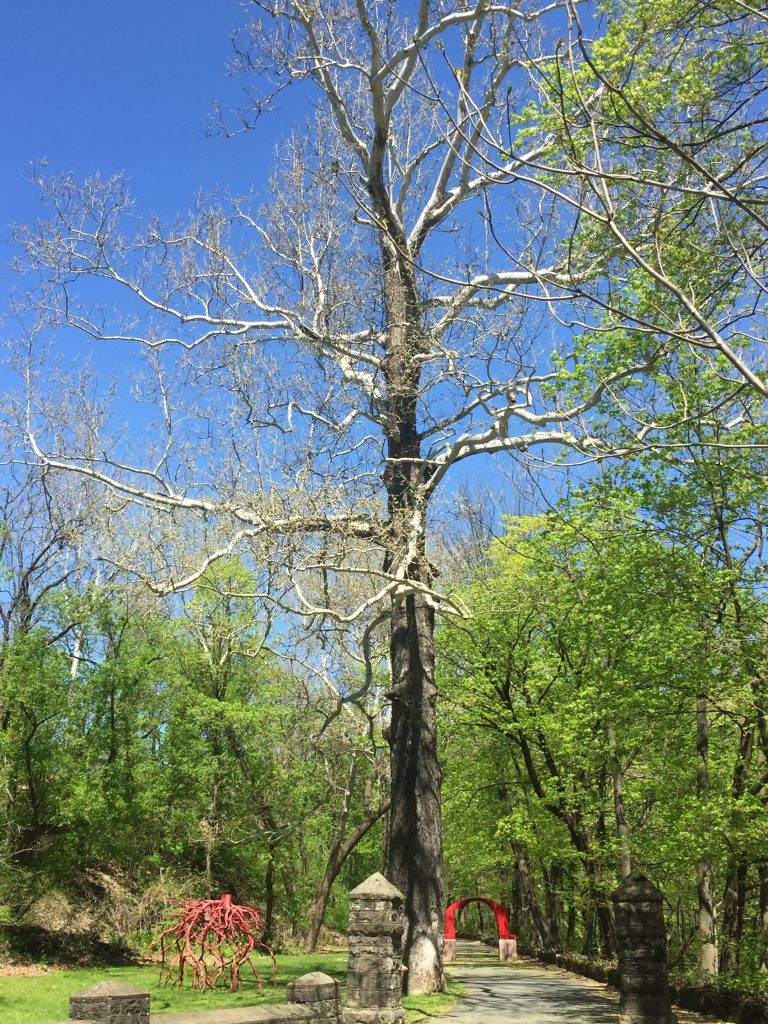Platanus occidentalis, circa 1757

Also referred to as the American plane tree, buttonwood, buttonball, and Eastern sycamore, American sycamores are native to North America, thriving up and down the East Coast, and are commonly seen growing in lowland environments along wetlands, streams, creeks, and rivers. They are somewhat tolerant and can be found in many areas of the landscape. Lewis and Clark mapped out rivers on their historic journey across the United States by getting to high vistas and sighting sycamores along riverbeds in the winter when the telltale white arms of the sycamore would stand out.
As you stand at the base of this majestic tree, dated in November 2018, you are greeted by a living being almost three centuries old, defined as a “living witness” to countless environmental events, the daily life of the original people of Easton, and the day-to-day antics of the little creatures that roam the ground below it. If you take the nature path just past Grace Gate, to the right, you will meet an even larger and older specimen along the Bushkill Creek, just before the old rail bridge. Growing within feet of the creek’s edge, this tree has a circumference of 229 inches and a diameter of 73 inches.
Trees inhale what we exhale, providing life-giving oxygen to us. The growth patterns of their branches (dendritic patterning) mirror the branches of the brachii in our lungs and the watershed mapping of rivers. The circular patterns seen in a cross-section of their trunks closely resemble a human fingerprint.
Historic events surrounding the witness tree:
Easton, Pa., founded in 1752. Our sycamore sprouted five years later on this site.
Captain John Clendenen, born June 7, 1757, in Easton, Pennsylvania. Revolutionary War veteran, enlisted on Feb. 11, 1776. Appointed corporal Feb. 14, 1776, made sergeant Feb. 18, 1780, made captain by brevet in 1784. Fought at Monmouth and Stoney Point. A prisoner of war on Royal Point Island in 1781 and wounded in battle. A Democrat and a delegate to the convention that nominated Thomas Jefferson for President.
Treaty of Easton, signed Oct. 26, 1758, during the French and Indian War; ceremony held in Easton, Pennsylvania.
William Parsons, Surveyor General and “father” of Easton, died Dec. 17, 1757.
Parson’s-Taylor House at 4th and Ferry Streets built in 1757.
Henry “Althouse” Allshouse born Feb. 8, 1757. He was a 15-year-old fifer during the Revolutionary War with General George Washington. Enlisted on July 9, 1776. Served in the House of Representatives from 1802-05 and 1812-18. Served in the Senate 1819-26.
World history:
Marquis de Lafayette, French general and aristocrat born Sept. 6, 1757. Close friend to George Washington, Alexander Hamilton, and Thomas Jefferson.
Paul Revere wed Sarah Orne Aug. 4, 1757, in Bridgewater, Massachusetts.
On Jan. 5, 1757, a failed assassination attempt on French King Louis XV by Damiens.
Alexander Hamilton born Jan. 11, 1757.
Indian Peace Medal Struck in 1757. Has the profile of King George II surrounded by the words “Let us look to the most High, who Blessed our Fathers with Peace.” On the edge has 37 notches. The center has a white man sitting on a stone beneath a tree, offering to a Native American seated on the ground beneath the sun a pipe of peace towards which the Native American extends his arm to receive it. Beneath that is the date 1757.
